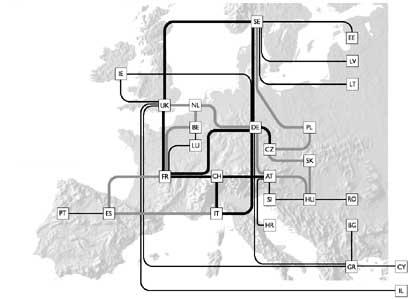Europe already has its Internet2
Elhuyar Fundazioa

Last December the Géant network started in Europe (www.dante.net/geant). This network aims to be the European version of the Internet2 network (www.internet2.edu) developed in the United States years ago. Internet2 is a high-speed Internet network, but it is not open, as it can only be used by scientists. The Gèant project began with the lack of a similar European network for scientific development. This network brings together nearly 3,000 centers from 32 countries. Internet2 is a network that groups about 180 centers. The speed of the Gèant network is 10Gb/s, four times faster than that of the United States. They also intend to accelerate Internet2 and in two years the speed will reach 10 Gbit/s, but by then the speed of Gèant will be 40 Gb/s.
In order to become aware of the importance of the European Union's commitment to Géant, it must be taken into account that in the next four years it will invest 200 million euros in this network.
Scientific network
Because Géant is not a normal network. There are many other networks in the world that surpass the Internet that we all use. Until recently, the most important thing was the US Internet2, a network used by the local scientific community. It must be taken into account that the Internet went from military hands to scientists in the 1980s, with which several scientists began to develop network projects. However, the success of WWW frustrated the use that scientists made of the Internet, since the collapse of the network did not allow to work. Scientists needed bandwidth to work, and the Internet situation in the 1990s did not allow.
Hence, in 1996 Internet2 emerged, a high-speed network for scientists that allows to work on projects that are totally unfeasible over the Internet. For example, an astronomer using Internet2 will be able to use real-time radio telescopes distributed around the world through your computer. But also, thanks to this network, there is more and more possibilities for distant scientists to work together. An example of this can be the project on the human genome.
But do not think that these networks have independent Internet cabling. In many cases both networks go for the same cabling, but bandwidth is much higher for Internet2 or Gèant than for regular users.
Advantages and problems of Gèant

Therefore, the almost only existing scientific network so far was Internet2, which being a network of the United States, was not of great use to European scientists. Scientists who wanted to connect from Europe to the Internet 2 could do so, but they did not achieve at all the same speed as American scientists.
The birth of Gèant has left behind Internet2. It started on December 1 and was then born with a speed of 10 Gbit/s, four times higher than Internet2. In two years it is also expected that the speed of Gèant is 40 Gbit/s. With this, European scientists are expected to have the same advantages as Americans, but the reality is very different.
It should be taken into account that, unlike the United States, the situation of all European telecommunication countries is very different. Therefore, of the 32 countries connected to this network, very few are able to use their full potential. For example, in the UK, France and Germany are fully willing to take advantage of the network; in Spain, RedIris offers access to the Gèant, which offers a speed of 2.5 Gbit/s. But, for example, Portugal still offers worse speed.
In addition, having a network that offers a very high connection speed is of no use if the centers that connect to this network are not prepared for it. If you want to fully take advantage of Gèant's speed, all centers should connect with a gigabit per second, but the reality is very different.

And in Euskal Herria, EuskoNixThis is not an independent network, but the speed of the Internet in Euskal Herria is expected to accelerate with this project. EuskoNix is the neutral point of the Internet developed in the Basque Country, that is, something like the public square in which Internet providers located in the Basque Country exchange their traffic. The goal is that when we connect to the Internet, and want to access the services of another nearby provider, we do not have to turn around the world to get to it and go directly to it. This type of neutral points are common in other places like Spain with EspaNix or Catalonia with CatNix. The neutral point of Euskal Herria, born with the impulse of the UPV-EHU, is expected to be in progress for the spring and will be implemented in the Leioa campus. The Basque Government will fund with 770,000 euros the first two years of infrastructure and operation necessary, from which the universities and merged companies will take charge. The signatories are: UPV, Universidad de Navarra, Mondragon Unibertsitatea, Universidad de Deusto, EuskalTel, Abrared, Sarenet, Ibercom, Mondragon Conet, EJIE and Osakidetza. All of them have been added the main Internet servers, except Telefonica, which is an important problem since Telefónica is the largest provider of traffic at the state level. |





